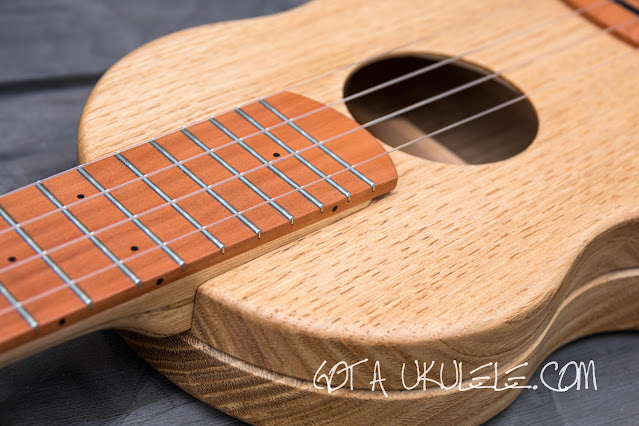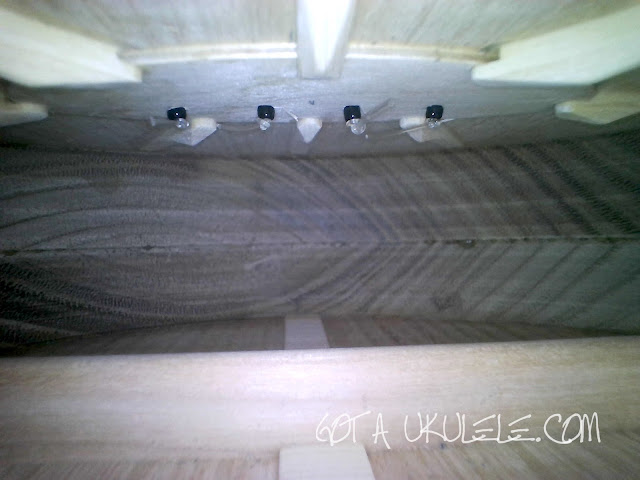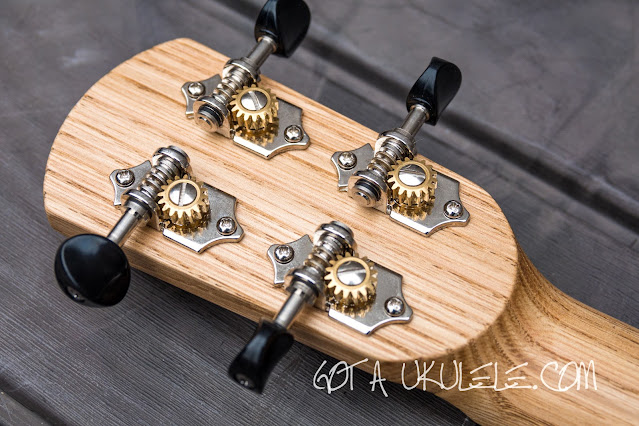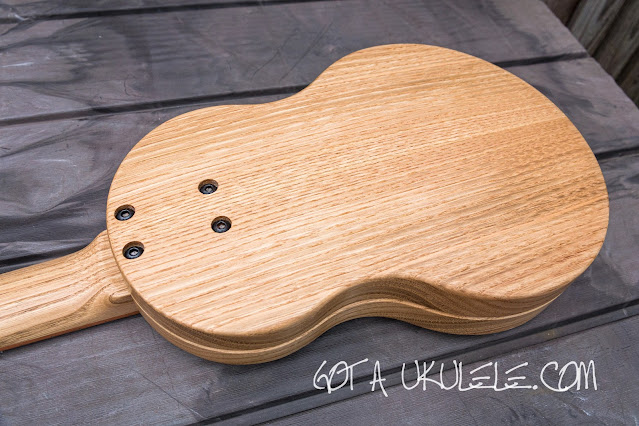Following on from a ukulele innovator last week, I return after my break to bring you something from another. This is the Galileo Tenor Ukulele from Antica Ukuleleria.
It's an honour to do what I do on Got A Ukulele, bringing you everything from the mass market instruments thought to the most revered brands on the planet. A real highlight for me though is looking at anything luthier built, and within that category I particularly enjoy those where the builder is working 'outside the box' and genuinely looking at developing new building techniques to take this instrument forward. Step up, once again, Antica Ukuleleria.
It's a brand well known to many ukulele fans, but if it's new to you, it's the luthier business of Italian luthier Marco Todeschini based in Corbiolo, Verona. I have looked at a few of his instruments now that you will find on the ukulele reviews page, and with each one that came along, his interesting developments became... well... more interesting! And they are not developments for the sake of being 'kooky' - he makes divine instruments that use a scientific approach to develop ukulele luthierie for the better. The Galileo is another new model for Marco which shows that, once again, he is digging deep into the science of what makes a ukulele work and trying to take advantage of that. More on that as we go through, and there's a lot to get through!
SUMMARY VIDEO REVIEW
On first look the Galileo is a modern shaped, double bout thin-line tenor ukulele, very reminiscent of Marco's other builds which are largely 'ukulele shaped' but have a certain style and flair to them that set them apart as something that is clearly a bit different. And that name harks to one of the most famous scientists of all time and was chosen to reflect his scientific approach to this one. This example is made from solid chestnut wood (from a tree that fell about 2km from where he lives - you can't get more locally sourced than that!), but is also available in Cherry. Incidentally, this is the first ukulele I have seen made from chestnut and think the grain is beautiful. But built like a regular ukulele, this is not. In developing this instrument Marco says he wanted to explore the science of separating the top of the instrument from being influenced by the other parts of the build. With a regular ukulele build a luthier will 'tune' the top bracing before the instrument is put together, but the moment you create the sound box, the sides come into play. Marco looked into a process of reducing how much sound energy the sides pulled out of the tuned top to try to isolate them from the projection and maximise volume from the soundboard. The concept is well accepted by master luthiers who recognise that thicker sides, or laminated / doubled sides can help with reducing the energy taken from the vibrating soundboard and leaving that to do it's thing, unclouded. But I guess regular building has to go with thin sides in order to bend the wood. Not here though. Fascinating. In fact this was meant to be a tool for him to learn the science of the sound impact rather than a model he was going to build, but he liked it so much he turned it into a whole new line!
To achieve his goal Marco has developed a method in which he takes two 'frames' of wood to create a complete set of sides in a 'ring' that are thicker than regular uke sides. This is done by taking two blocks and cutting out the middle section completely to leave a ukulele shaped ring that form the sides as a whole piece. Rather than routing out a chamber to create a bowl in the way a brand like Bonanza does, Marco chose to cut out the middle completely as shown in the images below. This reduces waste, and, in something of a genius idea, leaves him with two more blocks of wood that he uses to make his Allegro sopranino's (so each Galileo 'gives birth' to two bodies for building sopranino's..). But doing that leaves no top or back.. Marco then adds the separate solid top and back pieces (two for each) to the rings to create two modules which he independently braces and tunes before putting the two together in a dowelled and glued clamshell. The top and back pieces are applied so neatly and chamfered off you can't see the join and makes it look like a solid block. And he hasn't tried to 'hide' the way it's put the two halves together as he puts a slight chamfer on the joining edges of the top and back sections to leave a very tactile indented line around the middle which I think really sets it off. You'll also note that the top bouts are shallower front to back than the lower bouts, but more on that later. It all comes together that looks like a 'normal' thin-line ukulele but with a build quite different to the norm.
(Incidentally, in standard spec the top and back wood is the same as the wood of the side rings (so Chestnut here) but you can specify a spruce top if you prefer.)
 |
| Credit - Antica Ukuleleria |
The bridge is made of pear wood and is a through body style similar to the shape used on some other instruments in his line up. It's extremely well finished and smooth and holds a compensated top saddle made from black Corian. It looks great and minimal and I love the contrast to the top. Spacing here is 43mm.
The finish is a simple satin made from a shellac and oil / wax mix. Marco explains that he tries to avoid using synthetic finishes, but doesn't do so out of the usual 'claims' that they 'let the wood breathe' but simply that he likes to avoid using harmful chemicals which many of the synthetic polishes can contain. He's open about the fact that this does come at the expense of durability, but as he says, natural finishes have been used on stringed instruments for centuries (think of the priceless vintage Italian violins..) so with a bit of care for your instrument you will be fine. I think that's a bang on decision which I applaud, and I can categorically state that the finish on this example is flawless. There is no other decoration here which means that it's a simple looking instrument for sure (though that is what Marco was aiming at - focussing his efforts into the sound) - but I think there is enough that is 'different' here in the build to make it decorative in it's own right. It's right up my street personally and I have no doubt that any owner taking one of these to a uke club will have people enquiring about what is going on.
Inside is different from a regular ukulele so there is no need for kerfing on account of the thick sides. From what I can see of the braces though it's all very tidy, though in view of how he is constructing these modules I suspect he is taking as much care to the inside as the out! The back seems to be regularly braced and the top has a fan arrangement extending from the bridge plate. It's also clear that the solid top is extremely thin too to help with resonance. I'm sure it's the same for the back.
The neck is bolted on to the instrument into a pocket created by the two modules which, because of the shallower top bout as mentioned above raises the strings higher over the soundboard which is better for volume projection. That sounds like a throwaway comment and if you raise the strings over the soundboard this way you tend to make them high over the fingerboard, but more on that later. The neck is made from a single piece of chestnut and is finished smooth as glass. It has a pleasing flat back profile and a roomy 37mm nut (30mm G to A). I love the grain of the chestnut on this neck too. I do wonder whether the choice of 'bolt-on' versus 'set neck' will bring out the loonies with this one. But those debates only ever remind me of the endless arguments on guitar forums between Gibson and Fender fanboi's each who claim 'their' neck attachment is 'better' with neither side recognising the fact that both styles of guitar are stone-cold classic.. but.. I digress.. It doesn't matter to me so long as the instrument works.
Topping that is a fingerboard made from pear wood which is also as smoothly finished as the bridge. You will note the chestnut neck wood raising it on a wedge angle, compensating from that angle created by the shallower top to keep the strings lower whilst keeping that higher height over the soundboard. Very clever! It is fitted with 18 well dressed frets, joined at the 12th and complete with a zero fret to help for more reliable intonation. Small black outward facing position dots sit at the 5th, 7th, 10th, double 12th, and 17th and those are repeated down the side. The whole of the neck, front and back is wonderfully smooth and tactile. I love this neck.
Moving past the Corian nut we have an interesting headstock arrangement, carved backwards to create string break angle at the nut and also to counteract that angled joint to the body. It's a simple shape and this time is without the usual A.U. logo because he explains that he wanted to make this as cost effective as he can (and inlays take a lot of time!). I do miss the logo Marco, but understand your reasoning!
The tuners are Der Jung open gears with small black buttons which, I have said before, are comparable in quality to good Grover gears, so no complaints from me here. Very good quality.
Finishing it off are a set of Marco's fluorocarbon fishing line strings, which he lists as being 'rigorously hand-bought by hand-clicking on the internet, hand-cut and then hand-enveloped'.... a description that always makes me smile! And in this spec you are looking at a price of €720. Like all Marco's instruments it's a more serious price in the scheme of things, but remember that these are fully hand made and hand developed with a finish quality as good as I have ever seen in the uke world. Translating that to man-hours and I think it's actually cheap, and cheaper than some of the other instruments of his I have looked at. Bear in mind also that his waiting list can be extensive, so it's not just me who is understanding the price / quality mix with his ukuleles. Craftsmanship costs. Simple as that.
So I think you can tell that my first impressions here are very good indeed. I love the 'story' and the scientific method he employed to create this from the ground up. Even more so I like that he turned out a very attractive instrument that, despite being plain has so much about it that will still be a talking point.. (there's a common thread with that trait with Antica Ukuleleria instruments I find.). I can't find anything wrong with the build or the finish and I love the look. It's not heavy either at 685g and balances very well. That thin body is very nice to hold and that neck, as I say, is divine.
Much of what Marco told me in the back story was about maximising volume and projection from a thin-line so it's pleasing to note that it hits the spot on volume. It has a terrific bark and punch even without much effort on the strumming hand. Sustain is also good, and whilst not as long and ringing as some of those ultra paper thin instruments is remarkably good considering the build method. It's certainly there and better than most.
The tone is certainly bright and clear, which is something Marco identifies on his website, with the Cherry model being described as being more rounded. I am not going to pick between the two as I don't have the Cherry model here, but equally because I know that tastes vary and many like the more zingy ukuleles and many like the more laid back, darker sounds. Neither view is wrong and therefore I suspect neither wood type is better than the other - it just depends on what YOU prefer. ( I should say at this juncture that I regularly say I like darker woody instruments, but then the instrument I have probably banged on about the most in the last two years is the aNueNue Color series which are snappy, zingy and clear - so maybe my own tastes are changing). Stop rambling Baz...
The clarity of tone with that brightness is what first stands out to me. This is an incredibly clear and accurate sounding instrument however you play it with every string sitting perfectly in the mix with no hint of muddiness. Strummed it has a peppy jangly tone that reminds me of a concert (the second Antica Ukuleleria tenor to give me that impression) and makes for very enjoyable rhythmical play or adding strums to your picked play. It's what a strummed ukulele should sound like - and regular readers will know I DO like a bit of jangle!
The clarity of tone with that brightness is what first stands out to me. This is an incredibly clear and accurate sounding instrument however you play it with every string sitting perfectly in the mix with no hint of muddiness. Strummed it has a peppy jangly tone that reminds me of a concert (the second Antica Ukuleleria tenor to give me that impression) and makes for very enjoyable rhythmical play or adding strums to your picked play. It's what a strummed ukulele should sound like - and regular readers will know I DO like a bit of jangle!
Fingerpicking is an absolute dream too with music-box like chiming notes leaping out of the instrument with no drop off up the neck. It's incredibly pretty to just thumb strum individual notes as every one chimes like a bell. And all of that is made even more enjoyable, for my hands at least, by an incredibly comfortable neck. If Marco set out to 'let the soundboard' do the work then he achieved his goal as this is an incredibly accomplished instrument that performs admirably.
In fact I don't think I have fallen for an instrument as much as I have with this one for quite some time. Based on other instruments I have seen from Marco I kind of knew this one would be a cracker even before it arrived. Yet all things considered this is now my favourite Antica Ukuleleria model so far (and I REALLY loved the Sacco concept!). His attention to detail in the build process, particularly focussing on sound seems have gone into overdrive and I adore that goal. Importantly, it's not been done at the expense of anything else, as it has come together in a simple looking, but extremely pretty and wonderfully finished instrument. The sound is clear as a bell and it's just SO playable and sweet sounding.
I really think Marco is genuinely one of the most exciting and interesting ukulele luthiers creating instruments in the world today and these certainly deserve your attention if you want something 'different from the norm' that happens to play like a dream too.
Cor...
Cor...
Very highly recommended!
(p.s. Also check out his new website with a cool 'configurator' feature allowing you to see your spec upgrades / woods etc)
Model: Antica Ukuleleria Galileo
Scale: Tenor
Body: Solid Chestnut
Bridge: Pear, through body
Saddle: Corian (compensated)
Spacing at saddle: 43mm
Finish: Natural shellac oil/wax satin
Neck: Chestnut
Fingerboard: Pear
Frets: 18, 12 to body, with zero fret
Nut: Corian
Nut width: 37mm, 30mm G to A
Tuners: Der Jung gears
Strings: Marco's Strings Fluorocarbon
Strings: Marco's Strings Fluorocarbon
Weight: 685g
Country of origin: Italy
Price: €720
UKULELE PROS
Impeccable build and finish
Simple but alluring looks
Simple but alluring looks
Intriguing, well thought out build concept that works
Wonderful neck
Great volume
Good sustain
Clarity of tone is excellent
Peppy, jangly strums
Bell like highs on the picked notes right up the neck
Bell like highs on the picked notes right up the neck
Fair price
UKULELE CONS
Nothing
UKULELE SCORES
Looks - 9.5 out of 10
Fit and finish - 9.5 out of 10
Sound - 9.5 out of 10
Value for money - 9.5 out of 10
OVERALL UKULELE SCORE - 9.5 out of 10
OVERALL UKULELE SCORE - 9.5 out of 10
UKULELE VIDEO REVIEW
GOT A UKULELE IS NOT PAID BY BRANDS OR SHOPS - YOUR KIND DONATIONS ARE WHAT KEEP THE SITE GOING! THANKS FOR YOUR HELP!
SAY THANKS WITH A BEER!
BECOME A GOT A UKULELE PATREON
OR
THANKS!











As good a uke for the money as I've heard. This Italian Job really blows the doors off.
ReplyDeleteVery nice i really like it too, enjoy your reviews
ReplyDeleteYou did it to me again! You and Alex are draining my limited funds! : ) My Antiqued Chestnut Galileo should be ready by November. Thanks for the great review.
ReplyDeleteThis comment has been removed by a blog administrator.
ReplyDeleteI didn't want to make this anonymous, so I am repeating the comment I just made. Mine arri9ved yesterday. Wow! The finish is smoother than glass.
ReplyDelete